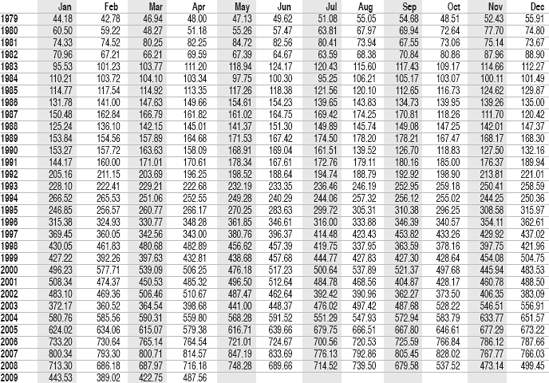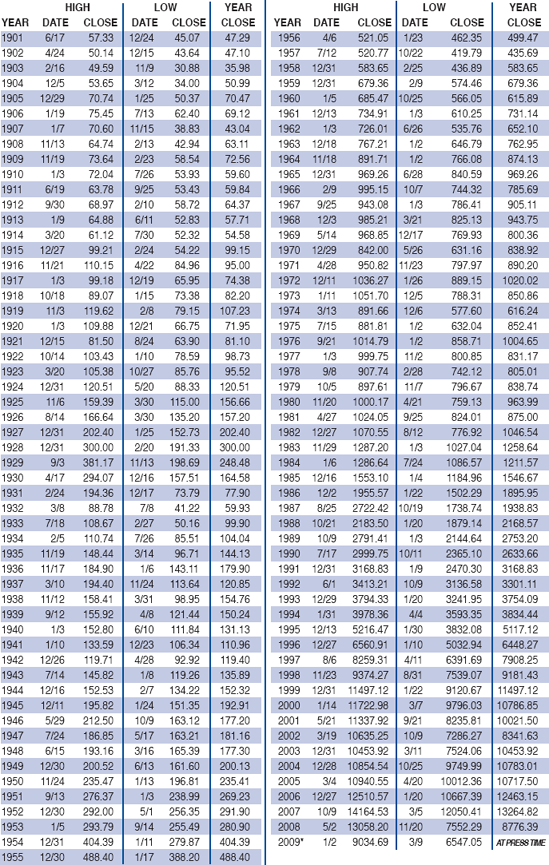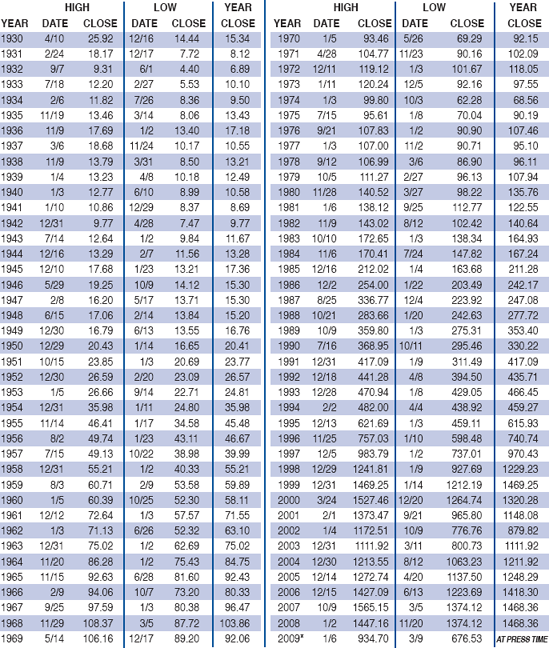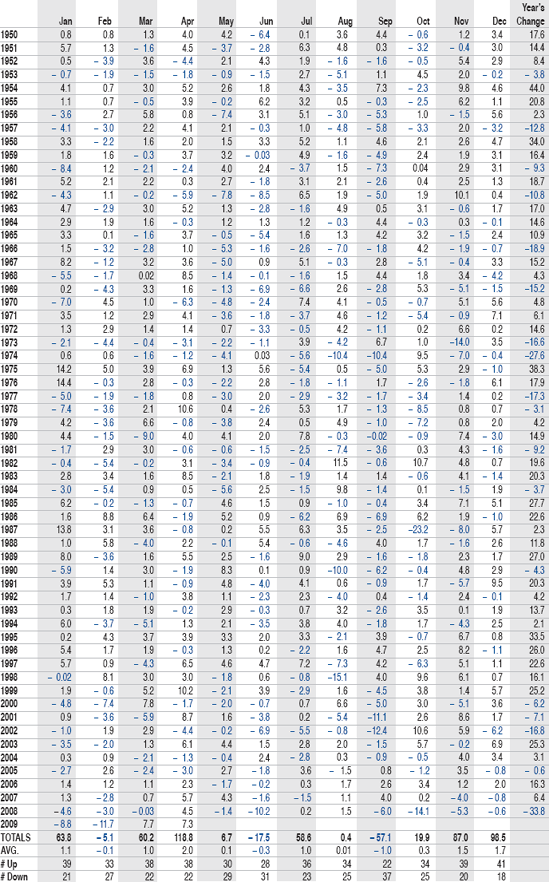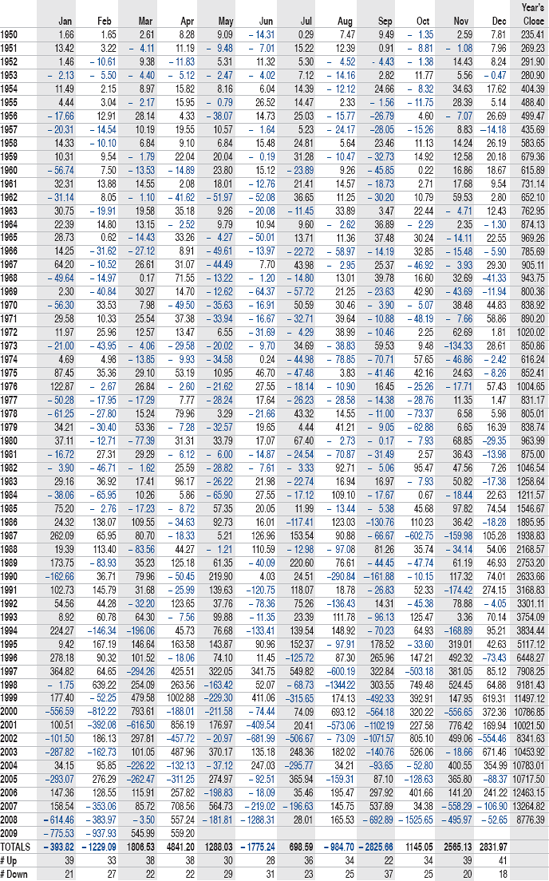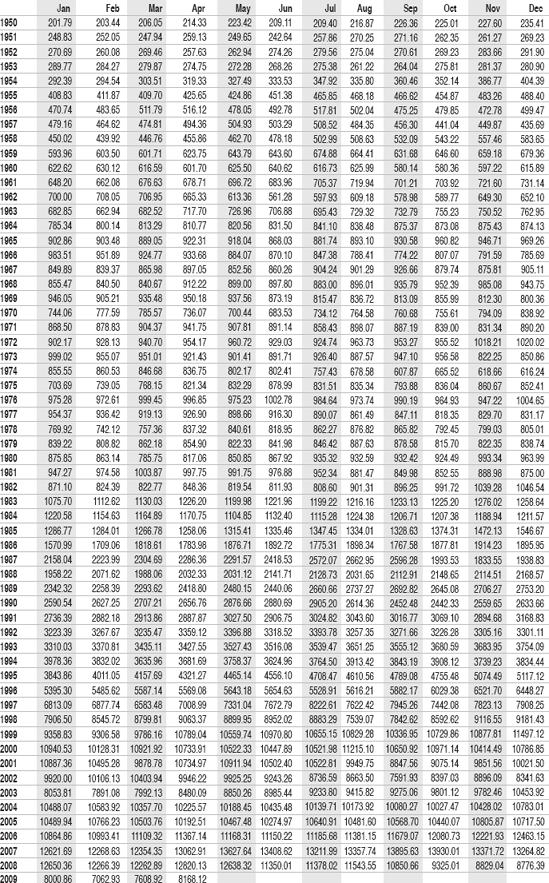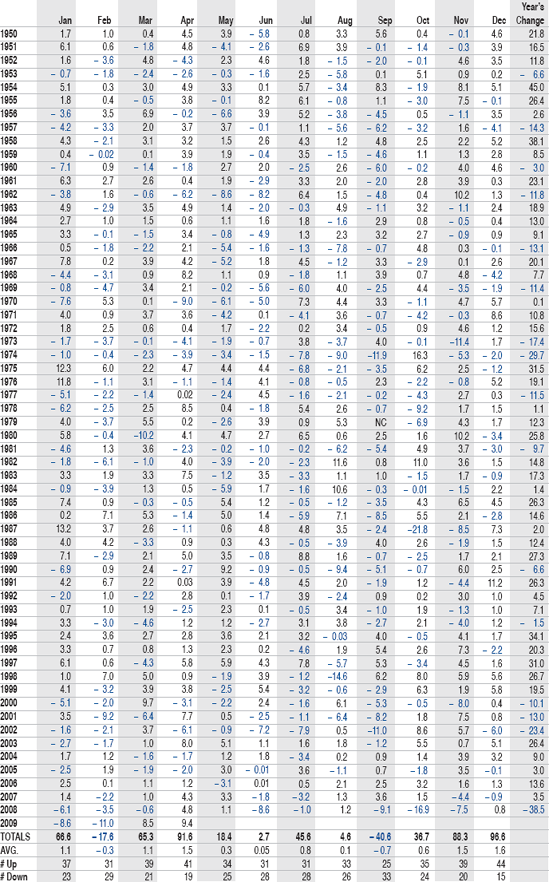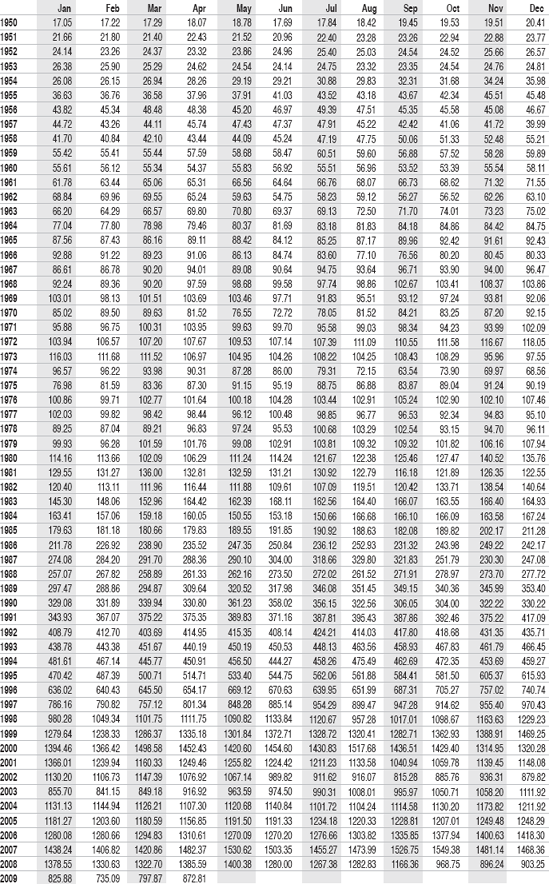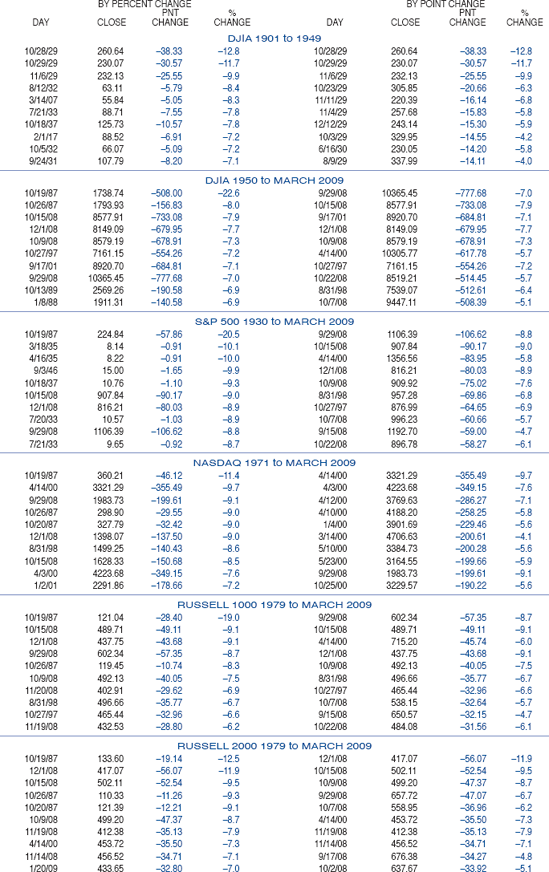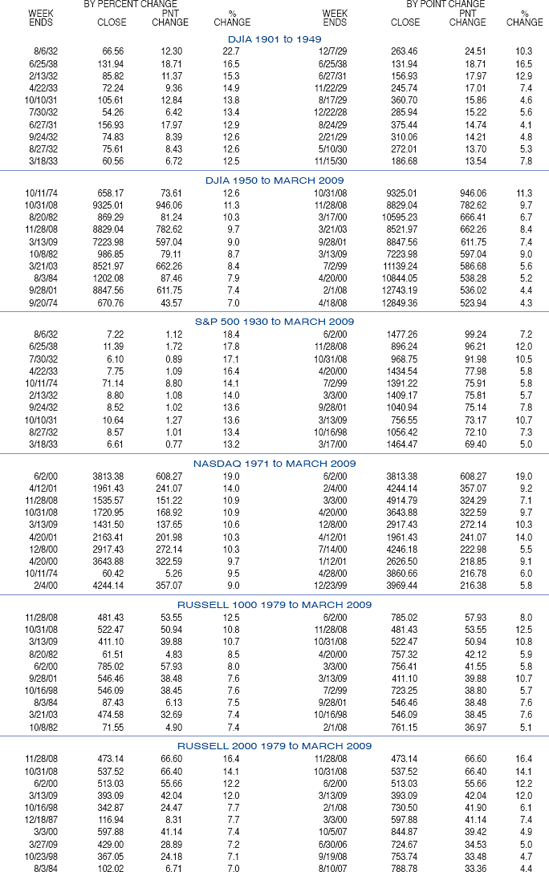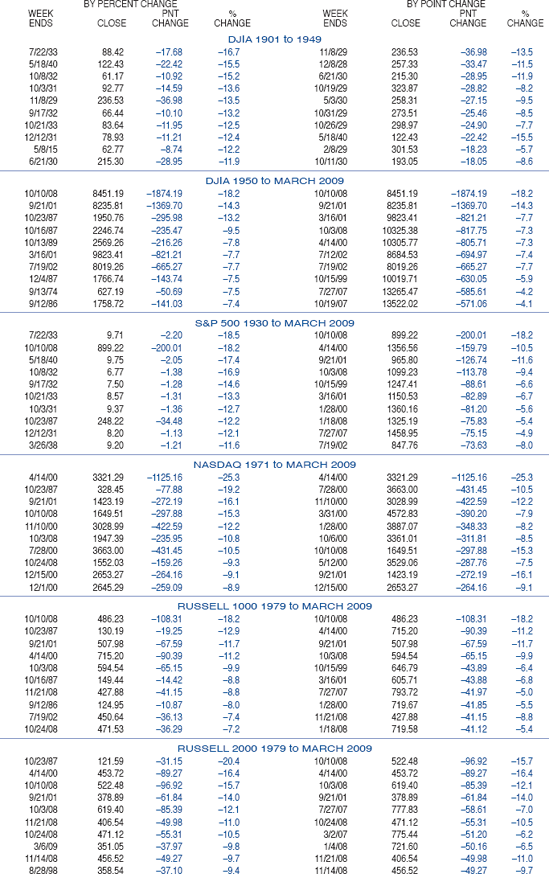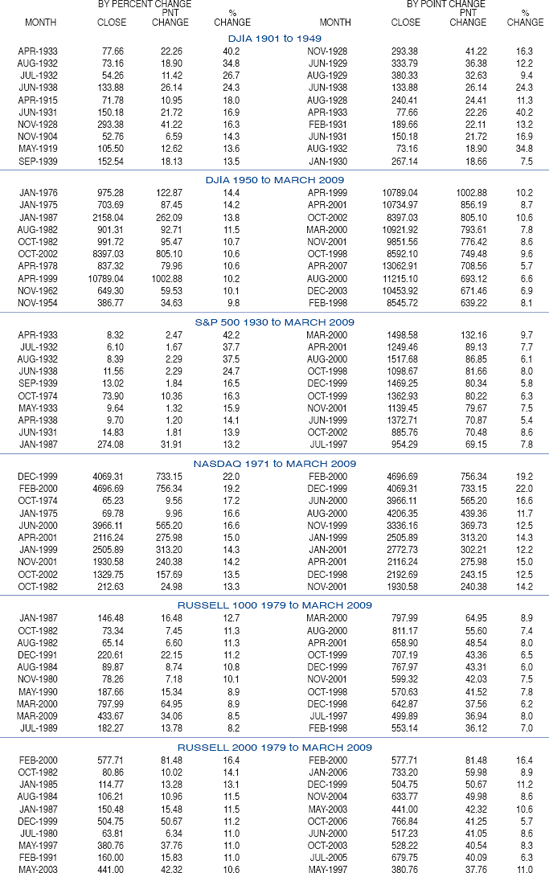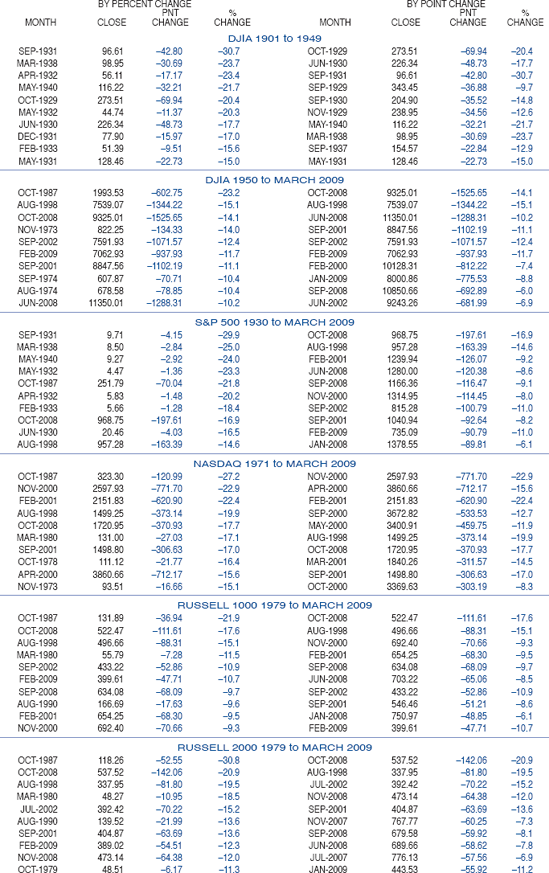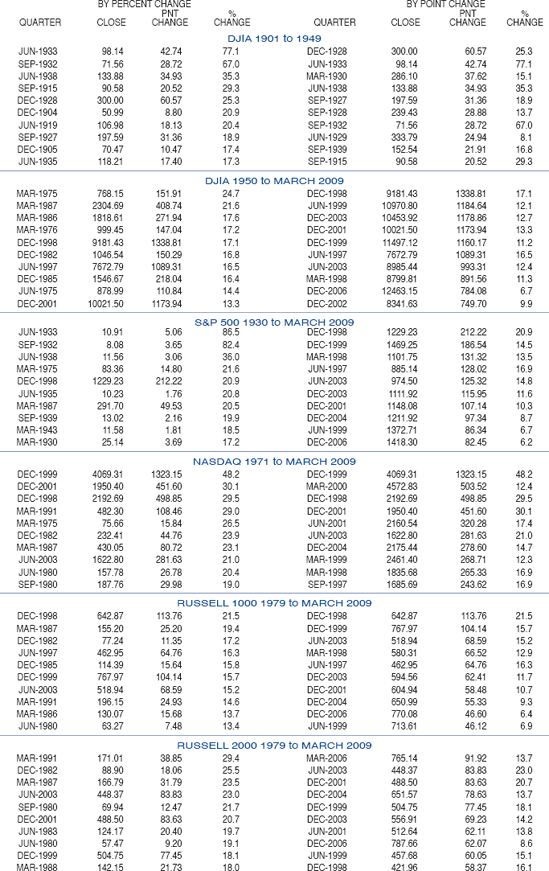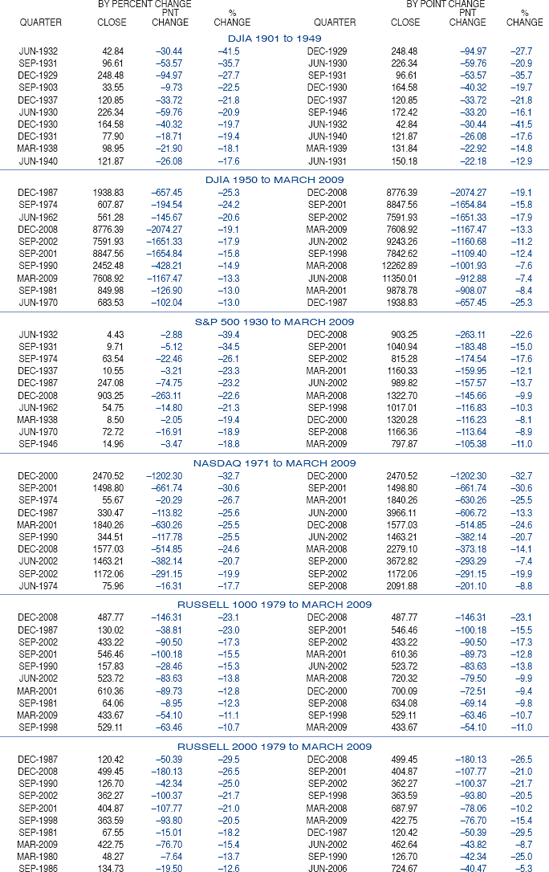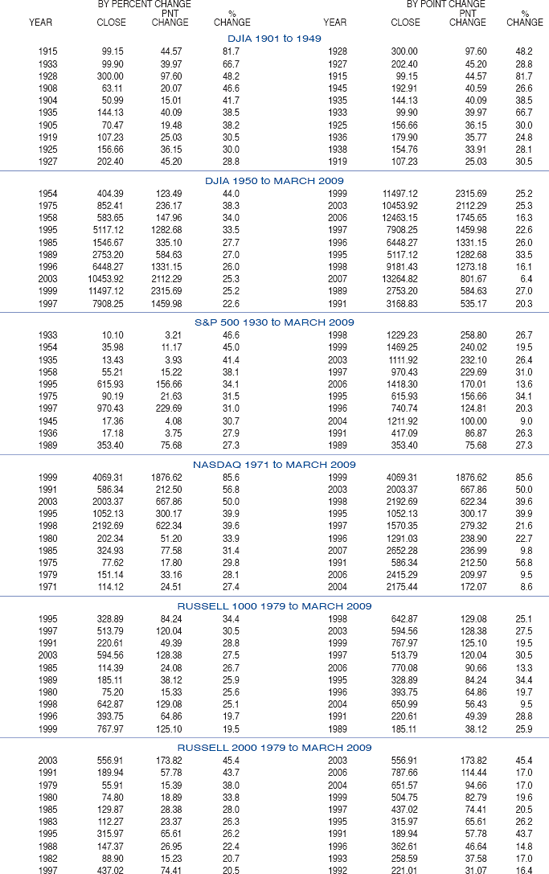THE % CHANCE OF THE MARKET RISING ON ANY TRADING DAY OF THE YEAR*
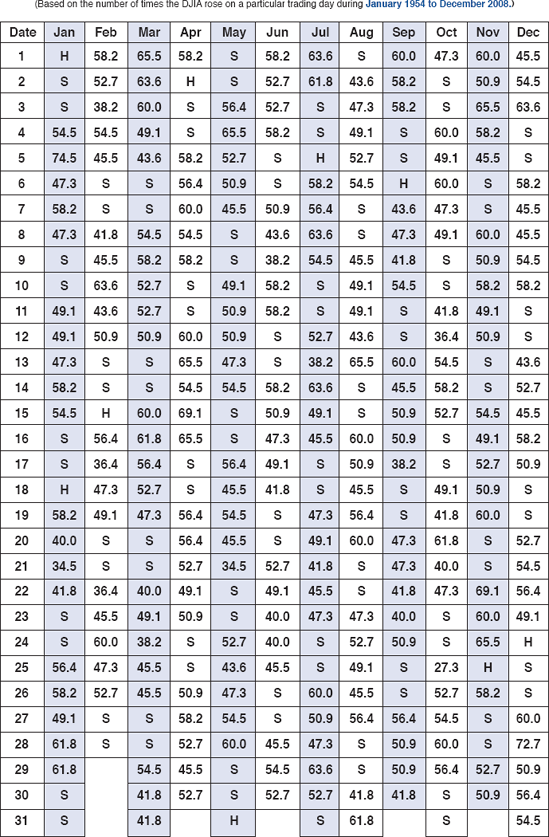
See new trends developing on pages 68, 88, 141–146.
THE % CHANCE OF THE MARKET RISING ON ANY TRADING DAY OF THE YEAR*

* See new trends developing on pages 68, 88, 141–146. ** Based on most recent 21–year period.
THE % CHANCE OF THE MARKET RISING ON ANY TRADING DAY OF THE YEAR*
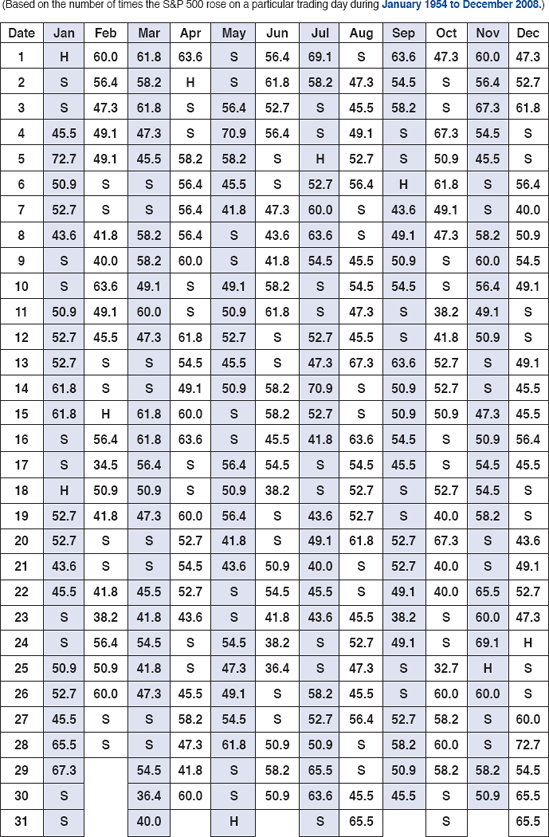
* See new trends developing on pages 68, 88, 141–146.
THE % CHANCE OF THE MARKET RISING ON ANY TRADING DAY OF THE YEAR*

* See new trends developing on pages 68, 88, 141–146. ** Based on most recent 21-year period.
THE % CHANCE OF THE MARKET RISING ON ANY TRADING DAY OF THE YEAR*
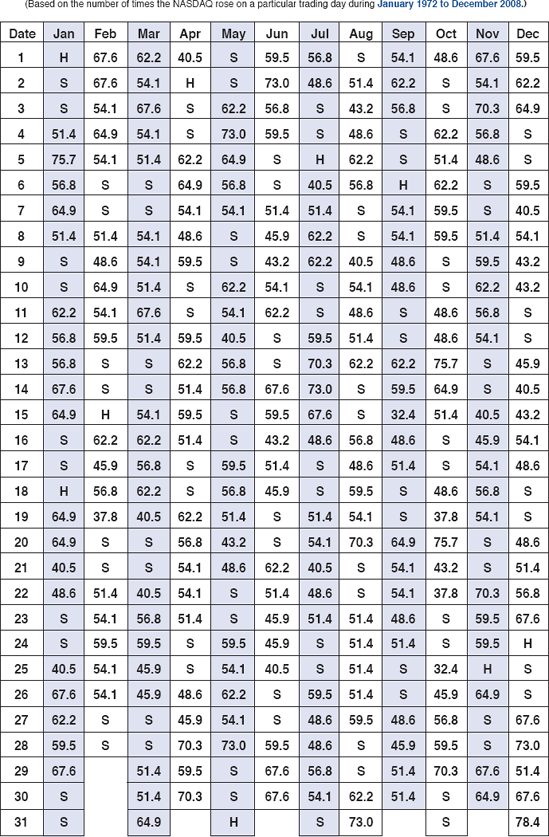
*See new trends developing on pages 68, 88, 141–146. Based on NASDAQ composite, prior to February 5, 1971, based on National Quotation Bureau indices.
THE % CHANCE OF THE MARKET RISING ON ANY TRADING DAY OF THE YEAR*
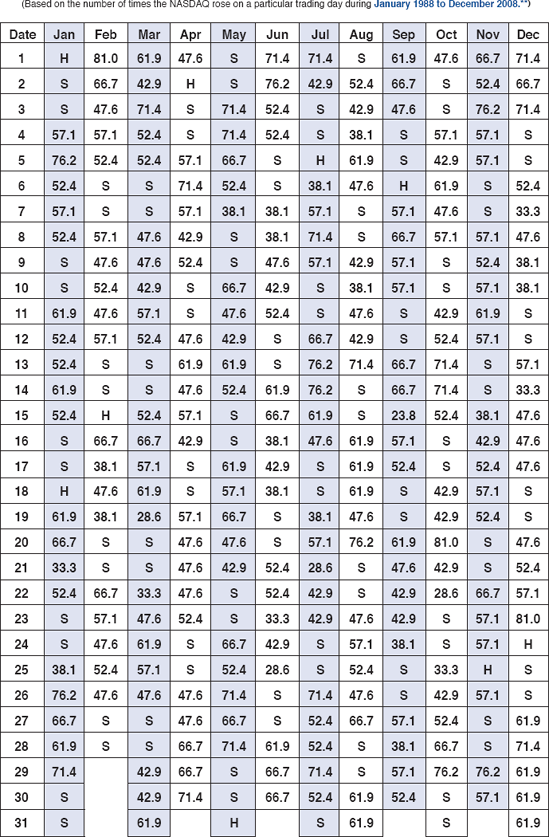
* See new trends developing on page 68, 88, 141–146. ** Based on most recent 21-year period.
THE % CHANCE OF THE MARKET RISING ON ANY TRADING DAY OF THE YEAR*
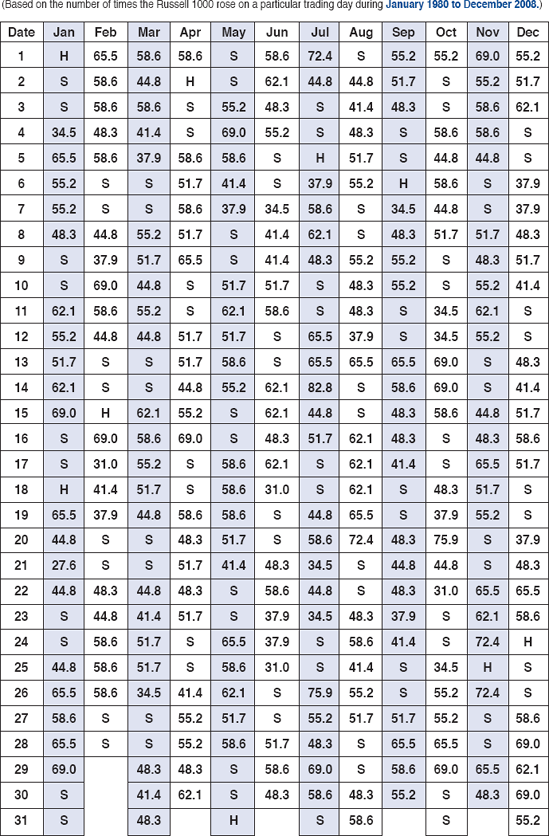
* See new trends developing on pages 68, 88, 141–146.
THE % CHANCE OF THE MARKET RISING ON ANY TRADING DAY OF THE YEAR*

* See new trends developing on pages 68, 88, 141–146.
By arranging each year's market gain or loss so the first and succeeding years of each decade fall into the same column, certain interesting patterns emerge—;strong fifth and eighth years; weak first, seventh, and zero years.
This fascinating phenomenon was first presented by Edgar Lawrence Smith in Common Stocks and Business Cycles (William-Frederick Press, 1959). Anthony Gaubis co-pioneered the decennial pattern with Smith.
When Smith first cut graphs of market prices into 10-year segments and placed them above one another, he observed that each decade tended to have three bull market cycles and that the longest and strongest bull markets seem to favor the middle years of a decade.
Don't place too much emphasis on the decennial cycle nowadays, other than the extraordinary fifth and zero years, as the stock market is more influenced by the quadrennial presidential election cycle, shown on page 130. Also, the last half-century, which has been the most prosperous in U.S. history, has distributed the returns among most years of the decade. Interestingly, NASDAQ suffered its worst bear market ever in a zero year, giving us the rare experience of witnessing a bubble burst.
Tenth years have the worst record within the Decennial Cycle and 2010 is a midterm election year, which has the second worst record of the 4-year presidential election cycle. However, the 53.8% Dow Jones industrials bear market decline at press time indicates that the piper has been paid. Prospects for a positive 2010, the first positive tenth year since 1980 are improving (see pages 26, 28, 32, 34, 78, and 130).
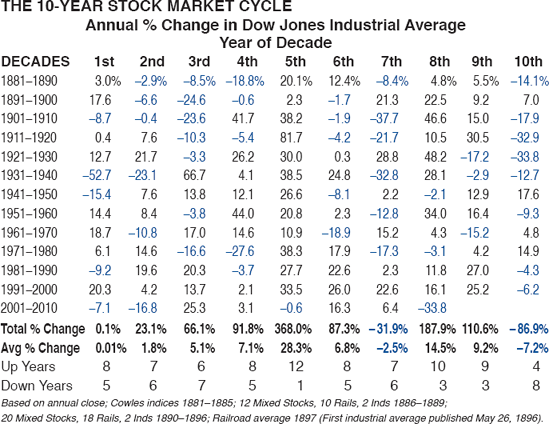
It is no mere coincidence that the last two years (pre-election year and election year) of the 44 administrations since 1833 produced a total net market gain of 718.5%, dwarfing the 243.3% gain of the first two years of these administrations.
Presidential elections every four years have a profound impact on the economy and the stock market. Wars, recessions, and bear markets tend to start or occur in the first half of the term; prosperous times and bull markets, in the latter half. After nine straight annual Dow gains during the millennial bull, the four-year election cycle reasserted its overarching domination of market behavior the last nine years. 2007 continued the streak of 17 up pre-elections in the last 68 years.

*Party in power ousted **Death in office ***Resigned D—Democrat, W—Whig, R—Republican
1 Based on annual close; Prior to 1886 based on Cowles and other indices; 12 Mixed Stocks, 10 Rails, 2 Inds 1886–1889; 20 Mixed Stocks, 18 Rails, 2 Inds 1890–1896; Railroad average 1897 (First industrial average published May 26, 1896).
Bear markets begin at the end of one bull market and end at the start of the next bull market (7/17/90 to 10/11/90 as an example). The high at Dow 3978.36 on 1/31/94, was followed by a 9.7 percent correction. A 10.3 percent correction occurred between the 5/22/96, closing high of 5778 and the intraday low on 7/16/96. The longest bull market on record ended on 7/17/98, and the shortest bear market on record ended on 8/31/98, when the new bull market began. The greatest bull super cycle in history that began 8/12/82 ended in 2000 after the Dow gained 1409% and NASDAQ climbed 3072%. The Dow gained only 497% in the eight-year super bull from 1921 to the top in 1929. NASDAQ suffered its worst loss ever from the 2000 top to the 2002 bottom, down 77.9%, nearly as much as the 89.2% drop in the Dow from the 1929 top to the 1932 bottom. The third longest Dow bull since 1900 that began 10/9/02 ended on its fifth anniversary. At press time the ensuing bear market has been viscous with the Dow down 53.8% at its March 2009 low, the second worst bear market since 1900. (See page 132 for S&P 500 and NASDAQ bulls and bears.)
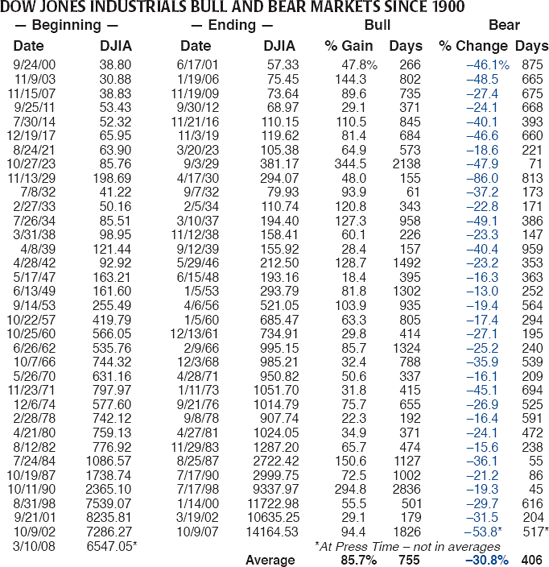
1900–2000 Data: Ned Davis Research
Based on Dow Jones industrial average.
The NYSE was closed from 7/31/1914 to 12/11/1914 due to World War I.
DJIA figures were then adjusted back to reflect the composition change from 12 to 20 stocks in September 1916.
A constant debate of the definition and timing of bull and bear markets permeates Wall Street like the bell that signals the open and close of every trading day. We have relied on the Ned Davis Research parameters for years to track bulls and bears on the Dow (see page 131). Standard & Poor's 500 index has been a stalwart indicator for decades and at times marched to a different beat than the Dow. With the increasing prominence of NASDAQ as a benchmark, we felt the time had come to add bull and bear data on the other two main stock averages to the Almanac. We conferred with Sam Stovall, Chief Investment Strategist at Standard & Poor's, and correlated the moves of the S&P 500 and NASDAQ to the bull and bear dates on page 131 to compile the data below on bull and bear markets for the S&P 500 and NASDAQ. Many dates line up for the three indices, but you will notice quite a lag or lead on several occasions, including NASDAQ's independent cadence from 1975 to 1980.
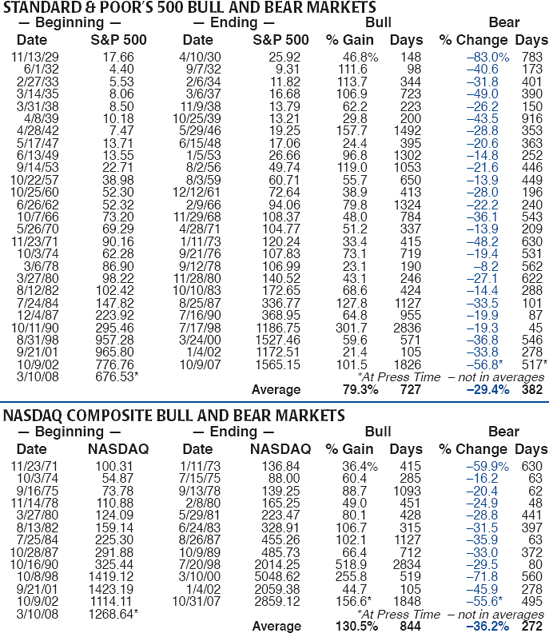
JANUARY DAILY POINT CHANGES DOW JONES INDUSTRIALS
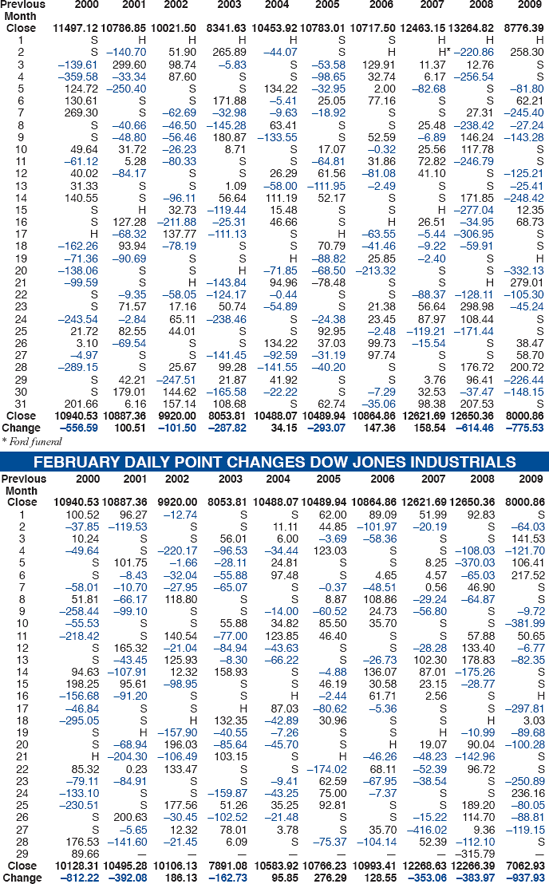
MARCH DAILY POINT CHANGES DOW JONES INDUSTRIALS

MAY DAILY POINT CHANGES DOW JONES INDUSTRIALS

* Reagan funeral
JULY DAILY POINT CHANGES DOW JONES INDUSTRIALS

SEPTEMBER DAILY POINT CHANGES DOW JONES INDUSTRIALS
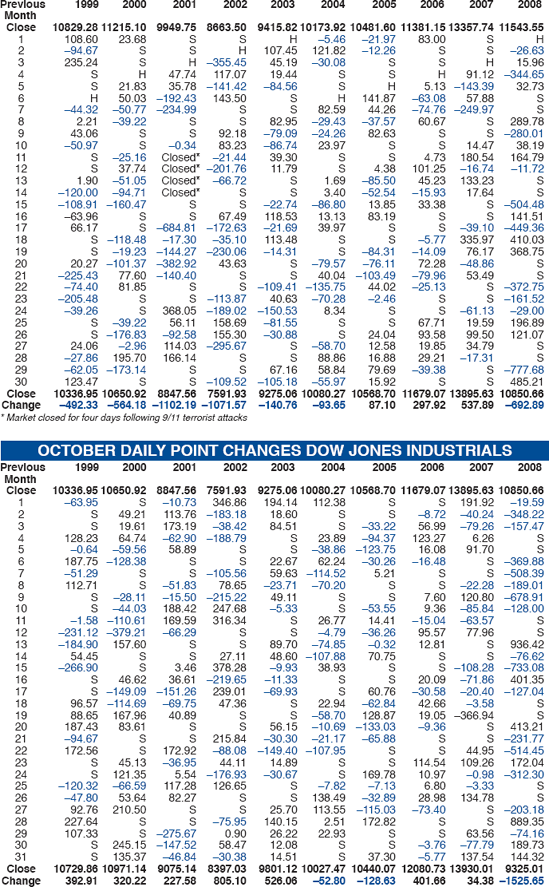
NOVEMBER DAILY POINT CHANGES DOW JONES INDUSTRIALS

Half-hourly data became available for the Dow Jones Industrial Average starting in January 1987. The NYSE switched 10:00 a.m. openings to 9:30 a.m. in October 1985. Below is the comparison between half-hourly performance 1987 to April 3, 2009, and hourly November 1963 to June 1985. Stronger openings and closings in a more bullish climate are evident. Morning and afternoon weaknesses appear an hour earlier.
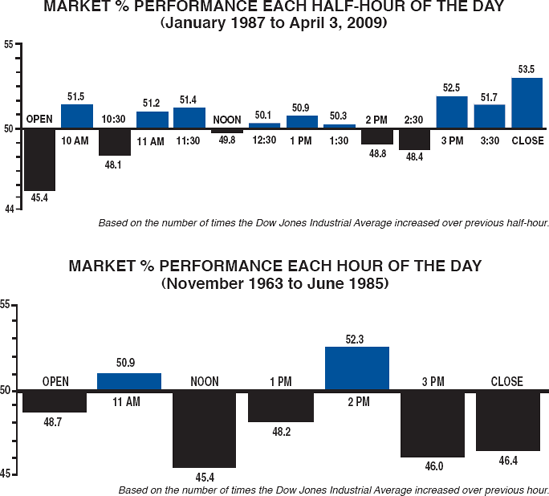
On the next page, half-hourly movements since January 1987 are separated by day of the week. From 1953 to 1989, Monday was the worst day of the week, especially during long bear markets, but times changed. Monday reversed positions and became the best day of the week and on the plus side eleven years in a row from 1990 to 2000.
During the last nine years (2001 to April 3, 2009) Monday, Thursday and Friday are net losers, Friday the worst. Only Tuesday and Wednesday are solid gainers, Tuesday the best (page 68). On all days stocks do tend to firm up near the close with weakness early morning and from 2 to 2:30 frequently.
From the chart showing the percentage of times the Dow Jones industrial average rose over the preceding half-hour (January 1987 to April 3, 2009), the typical week unfolds.
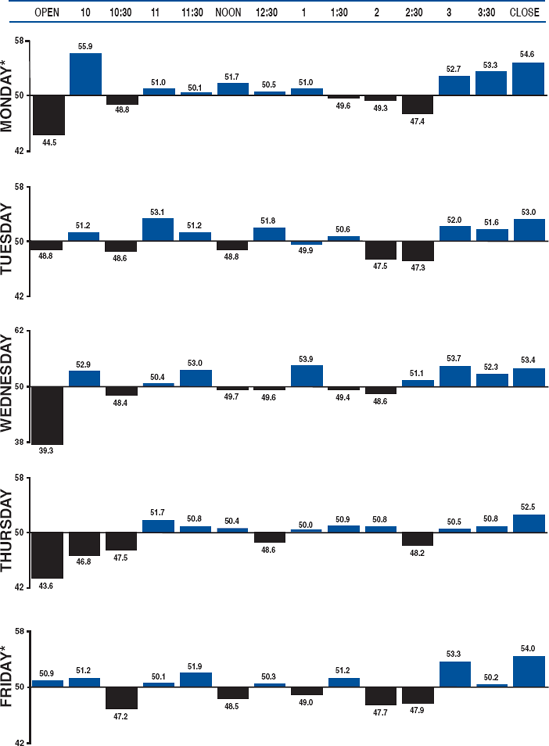
*Monday denotes first trading day of the week, Friday denotes last trading day of the week.
Between 1952 and 1989, Monday was the worst trading day of the week. The first trading day of the week (including Tuesday, when Monday is a holiday) rose only 44.3% of the time, while the other trading days closed higher 54.8% of the time. (NYSE Saturday trading discontinued June 1952.)
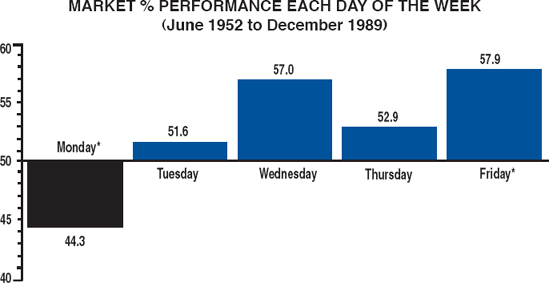
A dramatic reversal occurred in 1990—Monday became the most powerful day of the week. However, during the last eight and a third years, Tuesday has produced the most gains. Since the top in 2000, traders have not been inclined to stay long over the weekend nor buy up equities at the outset of the week. This is not uncommon during uncertain market times. See pages 68 and 143.
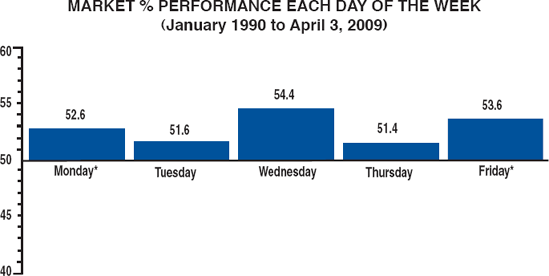
Charts based on the number of times S&P 500 index closed higher than previous day.
*Monday denotes first trading day of the week, Friday denotes last trading day of the week.
Despite 20 years less data, daily trading patterns on NASDAQ through 1989 appear to be fairly similar to the S&P on page 141 except for more bullishness on Thursdays. During the mostly flat markets of the 1970s and early 1980s, it would appear that apprehensive investors decided to throw in the towel over weekends and sell on Mondays and Tuesdays.
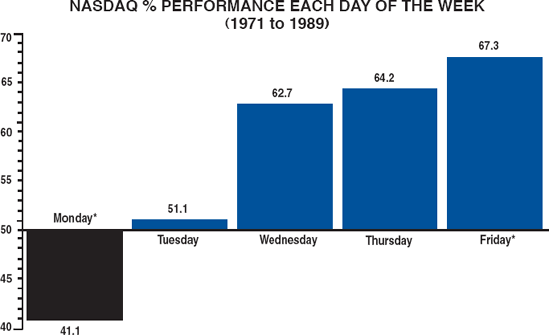
Notice the vast difference in the daily trading pattern between NASDAQ and S&P from January 1, 1990, to recent times. The reason for so much more bullishness is that NASDAQ moved up 1010%, over three times as much during the 1990 to 2000 period. The gain for the S&P was 332% and for the Dow Jones industrials, 326%. NASDAQ's weekly patterns are beginning to move in step with the rest of the market. Notice the similarities to the S&P since 2001 on pages 143 and 144, Monday and Friday weakness, midweek strength.
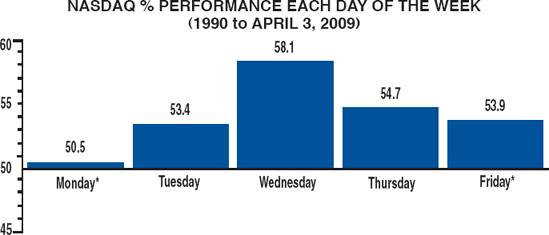
Based on NASDAQ composite, prior to February 5, 1971, based on National Quotation Bureau indices.
*Monday denotes first trading day of the week, Friday denotes last trading day of the week.
To determine if market trend alters performance of different days of the week, we separated 21 bear years—1953, '56, '57, '60, '62, '66, '69, '70, '73, '74, '77, '78, '81, '84, '87, '90, '94, 2000, '01, '02, and '08—from 36 bull market years. While Tuesday and Thursday did not vary much between bull and bear years, Mondays and Fridays were sharply affected. There was a swing of 10.5 percentage points in Monday's and 10.1 in Friday's performance. Tuesday is developing a reputation as the best day of the week.
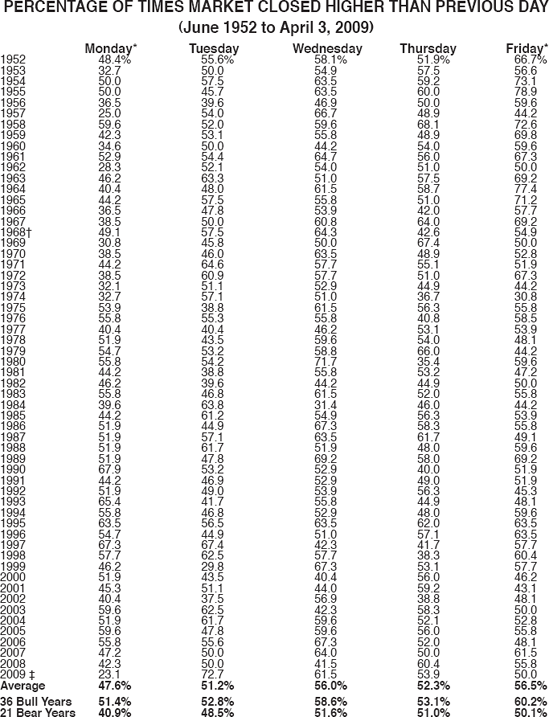
† Most Wednesdays closed last 7 months of 1968. ‡ Three months only, not included in averages.
*Monday denotes first trading day of the week, Friday denotes last trading day of the week.
After dropping a hefty 77.9% from its 2000 high (versus −37.8% on the Dow and −49.1% on the S&P 500), NASDAQ tech stocks still outpace the blue chips and big caps—but not by nearly as much as they did. From January 1, 1971, through May 1, 2009, NASDAQ moved up an impressive 1819%. The Dow (up 922%) and the S&P (up 852%) gained just over half as much.
Monday's performance on NASDAQ was lackluster during the three-year bear market of 2000–2002. As NASDAQ rebounded (up 50% in 2003) strength returned to Monday during 2003–2006. Market weakness in 2007, 2008, and early 2009 has been most severe on Monday and Friday.

Based on NASDAQ composite; prior to February 5, 1971, based on National Quotation Bureau indices.
† Three months only, not included in averages.
*Monday denotes first trading day of the week, Friday denotes last trading day of the week.
For many years, the last trading day of the month, plus the first four of the following month, were the best market days of the month. This pattern is quite clear in the first chart showing these five consecutive trading days towering above the other 16 trading days of the average month in the 1953–1981 period. The rationale was that individuals and institutions tended to operate similarly, causing a massive flow of cash into stocks near beginnings of months.
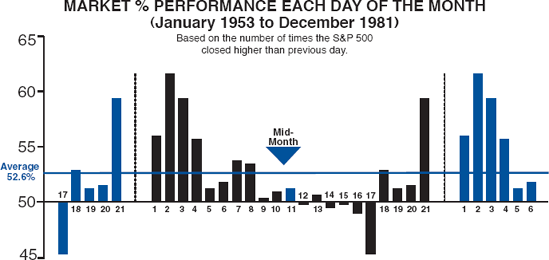
Clearly "front-running" traders took advantage of this phenomenon, drastically altering the previous pattern. The second chart from 1982 onward shows the trading shift caused by these "anticipators" to the last three trading days of the month, plus the first two. Another astonishing development shows the ninth, tenth, and eleventh trading days rising strongly as well. Perhaps the enormous growth of 401(k) retirement plans (participants' salaries are usually paid twice monthly) is responsible for this new mid-month bulge. First trading days of the month have produced the greatest gains in recent years (see page 62).
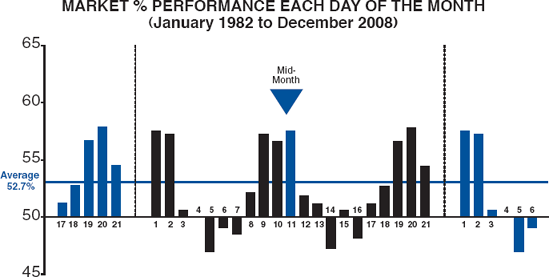
NASDAQ stocks moved up 58.1% of the time through 1981 compared to 52.6% for the S&P on page 145. Ends and beginnings of the month are fairly similar, specifically the last plus the first four trading days. But notice how investors piled into NASDAQ stocks until mid-month. NASDAQ rose 118.6% from January 1, 1971, to December 31, 1981, compared to 33.0% for the S&P.
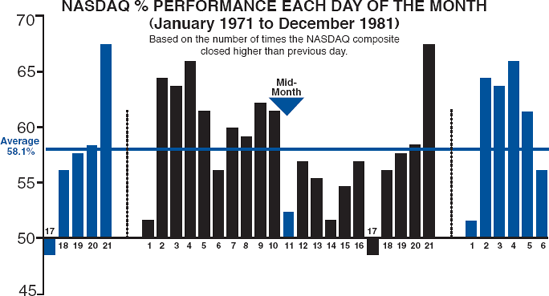
After the air was let out of the market 2000–2002, S&P's 637% gain over the last 27 years is more evenly matched with NASDAQ's 705% gain. Last three, first four and middle ninth and tenth days rose the most. Where the S&P has five days of the month that go down more often than up, NASDAQ has one. NASDAQ exhibits the most strength on the last trading day of the month, however, over the last 10 years, last days have weakened considerably, down more often then not.
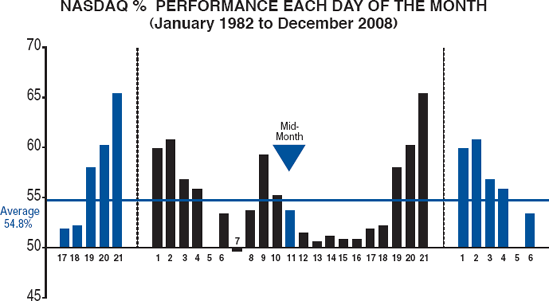
The most important observation to be made from a chart showing the average monthly percent change in market prices since 1950 is that institutions (mutual funds, pension funds, banks, etc.) determine the trading patterns in today's market.
The "investment calendar" reflects the annual, semi-annual and quarterly operations of institutions during January, April and July. October, besides being the last campaign month before elections, is also the time when most bear markets seem to end, as in 1946, 1957, 1960, 1966, 1974, 1987, 1990, 1998 and 2002. (August and September tend to combine to make the worst consecutive two-month period.)
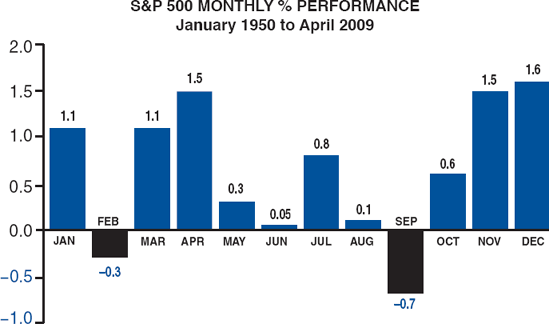
Average month-to-month % change in S&P 500.
(Based on monthly closing prices.)
Unusual year-end strength comes from corporate and private pension funds, producing a 4.2% gain on average between November 1 and January 31. In 2007–2008 these three months were all down for the fourth time since 1930; previously in 1931–1932, 1940–1941 and 1969–1970, all bear markets. September's dismal performance makes it the worst month of the year. In the last 14 years it has been up eight times—down five in a row 1999–2003.
In midterm election years since 1950, the best three months are October +3.3% (11–4), November +2.8% (12–3), and December +1.6% (11–4). February, March, April and July are also gainers while January, May, August and September are losers and June is worst with an average 1.9% loss.
See page 44 for monthly performance tables for the S&P 500 and the Dow Jones industrials. See pages 48 and 50 for unique six-month switching strategies.
On page 74 you can see how the first month of the first three quarters far outperforms the second and the third months since 1950 and note the improvement in May's and October's performance since 1991.
The two-and-a-half-year plunge of 77.9% in NASDAQ stocks between March 10, 2000, and October 9, 2002, brought several horrendous monthly losses (the two greatest were November 2000, −22.9%, and February 2001, −22.4%), which trimmed average monthly performance over the 381/3-year period. Ample Octobers in 8 of the last 11 years, including two huge turnarounds in 2001 (+12.8%) and 2002 (+13.5%) has put bear-killing October in the number one spot since 1998. January's 3.0% average gain is still awesome, and twice S&P's 1.3% January average since 1971.
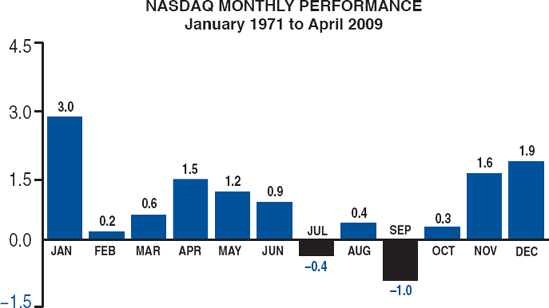
Average month-to-month % change in NASDAQ composite, prior to February 5, 1971, based on National Quotation Bureau indices.
(Based on monthly closing prices.)
Bear in mind when comparing NASDAQ to the S&P on page 147 that there are 22 fewer years of data here. During this 381/3-year (1971–April 2009) period, NASDAQ gained 1816%, while the S&P and the Dow rose only 847% and 807%, respectively. On page 54 is a statistical monthly comparison between NASDAQ and the Dow and on page 58, NASDAQ's eight-month switching strategy.
Year-end strength is even more pronounced in NASDAQ, producing a 6.5% gain on average between November 1 and January 31—1.5 times greater than that of the S&P 500 on page 147. September is the worst month of the year for the over-the-counter index as well, posting a deeper average loss of −1.0%. These extremes underscore NASDAQ's higher volatility and potential for moves of greater magnitude.
In midterm election years since 1971, the best three months are November +4.2% (6-3), October +4.1% (7-2), and March +1.5% (6-3). February and December are also modest gainers while January, April, May, June, August, and September are losers, July is worst with an average 3.4% loss.
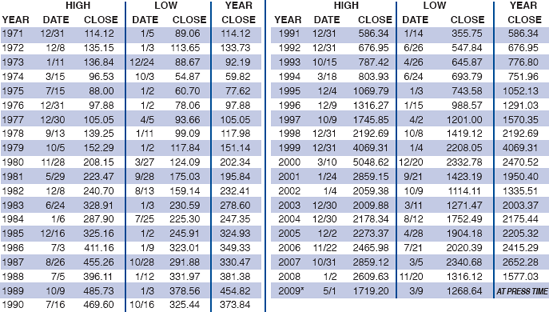
RUSSELL 1000 ANNUAL HIGHS, LOWS, & CLOSES SINCE 1979

RUSSELL 2000 ANNUAL HIGHS, LOWS, & CLOSES SINCE 1979
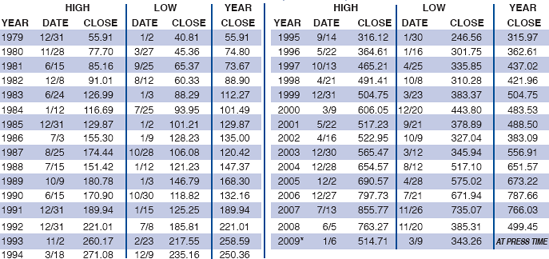
*Through May 1, 2009

Based on NASDAQ composite, prior to February 5, 1971, based on National Quotation Bureau indices.
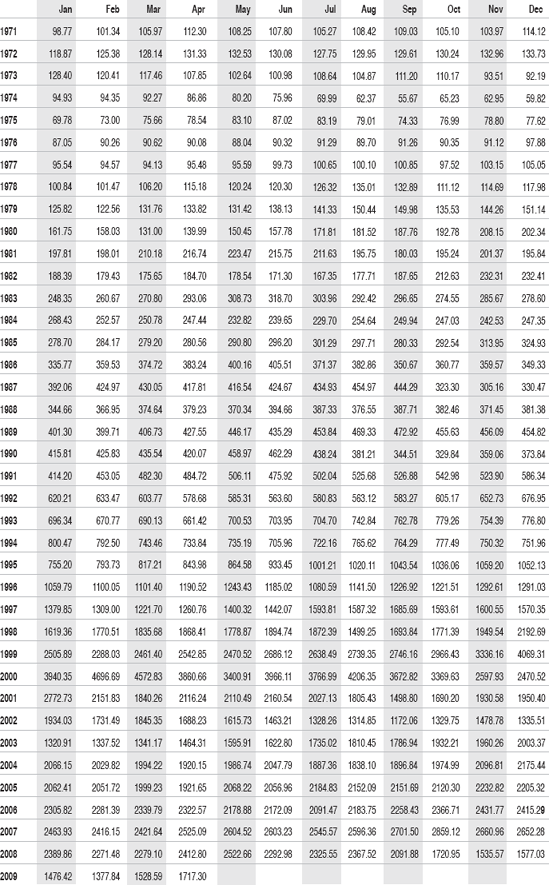
Based on NASDAQ composite, prior to February 5, 1971, based on National Quotation Bureau indices.

RUSSELL 1000 INDEX MONTHLY CLOSING PRICES SINCE 1979

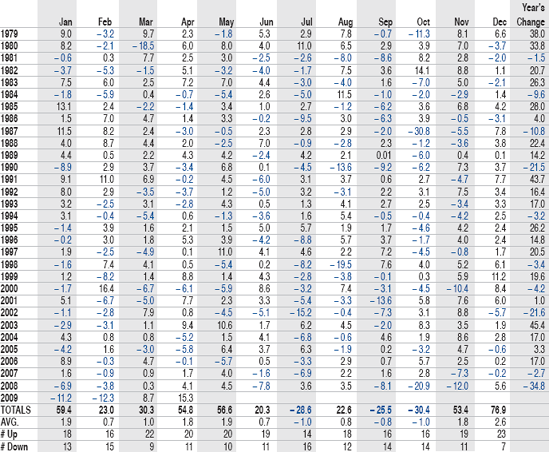
RUSSELL 2000 INDEX MONTHLY CLOSING PRICES SINCE 1979
